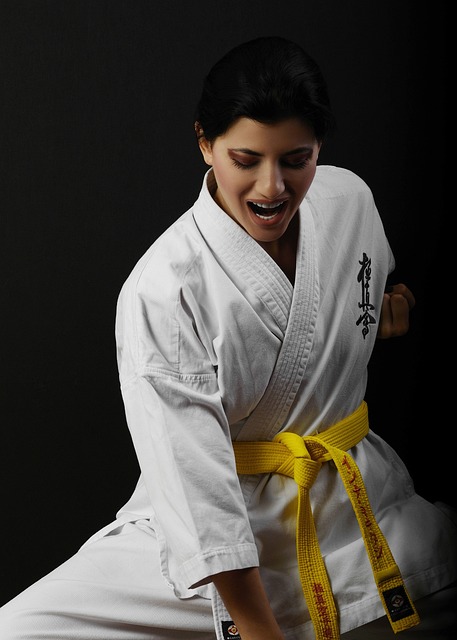The cultural and functional significance of traditional karate attire, such as the gi, is explored, highlighting its dual role in preserving karate's heritage and serving as practical gear for modern training. The white jacket, straight-legged trousers, and obi belt not only signify skill levels but also facilitate flexibility and movement essential for karate techniques. For those interested in "train karate home," the gi's design remains relevant, allowing for unrestricted motion during practice. The belt system from white to black represents a practitioner's progress and mastery of karate. Setting up a home dojo for karate requires careful consideration of space, safety, and equipment to ensure a focused and effective training environment. Key elements include choosing a distraction-free area with shock-absorbent flooring, proper lighting, and a wall mirror for self-assessment. Adding focus mitts, kick shields, a target, or heavy bag, and possibly traditional weapons like nunchaku or sword, can enhance the home training experience. Maintaining an organized, clean, and tidy space at home promotes discipline and safety, making it possible to train karate effectively outside of a traditional dojo setting.
Embarking on a journey in karate requires more than mastering its dynamic moves; it includes donning the appropriate attire. This article delves into the quintessential karate outfit, often overlookinged yet integral to the discipline. From understanding the traditional garb that marks a practitioner’s readiness to setting up a home dojo for personal training, we explore everything you need to know to train karate effectively at home.
- Mastering the Essentials: The Comprehensive Guide to the Traditional Karate Outfit
- Setting Up Your Home Dojo: Essential Tips for Training Karate in Your Own Space
Mastering the Essentials: The Comprehensive Guide to the Traditional Karate Outfit

When practicing the art of karate, the traditional attire serves as more than just clothing; it is a symbol of respect for the discipline and its origins. This article delves into the essential elements of the classic karate outfit, which has evolved over time to cater to both practicality in training and adherence to tradition. The quintessential karate garb typically consists of a jacket known as a gi, trousers, and a belt, or obi, which collectively signify the wearer’s rank or level within the martial art. The top, or jacket, is traditionally white, representing purity and humility, and is cut to facilitate freedom of movement during practice. It buttoned up the front and has long sleeves that can be folded at the wrists for various techniques.
The trousers, also white, are straight-legged and designed to allow karateka to move without restriction, providing comfort and ease during training sessions like those conducted at home with “train karate home” programs. The belt, which varies in color from white to black and beyond, indicates the wearer’s skill level and discipline within the art. Each color represents a different level of proficiency and understanding of karate principles. Prospective practitioners looking to train karate at home will find that acquiring the proper attire is an integral part of their training regimen, setting them up for success in mastering this martial art form. Understanding the significance of each piece of the traditional outfit ensures that one not only looks the part but also respects the tradition and embodies the essence of karate’s philosophy.
Setting Up Your Home Dojo: Essential Tips for Training Karate in Your Own Space

Creating a home dojo for training Karate offers a personalized space for practice and development. To begin, designate a dedicated area in your home that is free from distractions and has enough room to move freely, executing punches, kicks, and blocks without obstruction. Ensure the flooring is safe and shock-absorbent; mats are ideal for cushioning falls and providing comfort during longer training sessions. Proper lighting is crucial for maintaining awareness of your surroundings and for ensuring visibility when practicing techniques.
In terms of equipment, a wall mirror can be invaluable, allowing you to observe and correct your stances and movements. A focus mitt or kick shield for a partner can enhance your ability to practice specific drills, mimicking the interaction with an opponent. Additionally, having a target or heavy bag for striking can simulate various combat scenarios and is beneficial for maintaining technique consistency. Organize your space efficiently, storing equipment like nunchaku or sword if you practice Shotokan or other styles that include these elements. Regularly maintain your training area, keeping it clean and tidy to promote a disciplined mindset and ensure safety at all times. With careful planning and attention to detail, your home dojo can become an effective environment for training Karate and honing your skills.
In wrapping up our exploration of the traditional karate outfit and the practicalities of training karate at home, it’s clear that understanding the attire and setting up a dedicated space for practice are key components to effective martial arts training. The traditional garb not only resonates with the discipline’s history but also serves a functional purpose in modern home dojos. For those who train karate at home, ensuring your environment is conducive to learning and practicing can enhance your skill development and appreciation for the art. By mastering the essentials of both technique and setting, you can embark on a rewarding journey in karate, regardless of your physical location. Remember to respect the traditions while embracing the adaptability that a home dojo offers. With the right outfit and environment, training karate at home becomes an accessible and enriching experience for anyone interested in this dynamic discipline.
